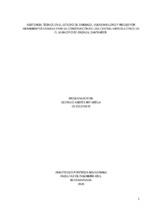| dc.contributor.advisor | Bautista García, Gerardo | |
| dc.contributor.author | Rey Ardila, Gustavo Andrés | |
| dc.coverage.temporal | 2020 | |
| dc.date.accessioned | 2021-09-02T19:47:14Z | |
| dc.date.available | 2021-09-02T19:47:14Z | |
| dc.date.issued | 2020 | |
| dc.identifier.uri | http://hdl.handle.net/20.500.11912/9098 | |
| dc.description | 79 páginas | spa |
| dc.description.abstract | Entre los municipios de Onzaga y San Joaquín en Santander, se efectuó un estudio de factibilidad para la construcción de una central hidroeléctrica enfocándose en los agentes detonantes de grandes movimientos en masa y una inspección de las actuales estructuras hidráulicas del sector. Mediante visitas de campo, se buscó enlistar la totalidad de los eventos para poder clasificarlos, medir sus impactos y realizar la zonificación, teniendo en cuenta la hidrología, fallas geológicas y geomorfología. Cabe anotar que este proceso paso por 3 fases, los análisis y registros con apoyo de entidades nacionales, la clasificación mediante formularios que permitieron hacer un inventario de los eventos de la zona y la realización del mapeo agrupando la información recolectada en el software ArcGis. Por otra parte, en las visitas de campo. también se evaluó el estado de las estructuras hidráulicas presentes en la zona, donde se encontraron Acueductos Veredales con tanques de almacenamiento, desarenadores, tuberías para captación y transporte para consumo humano y estructuras hidráulicas con tanques de sedimentación, tuberías de transporte y bebederos para consumo animal. | spa |
| dc.description.abstract | Between the municipalities of Onzaga and San Joaquin in Santander, a feasibility study was carried out for the construction of a hydroelectric plant focusing on the detonating agents of large mass movements and an inspection of the current hydraulic structures of the sector. Through field visits, we made a list of all the events in order to classify them, measure their impact and implement zoning, taking into account hydrology, geological faults and geomorphology. It\'s worth noting that this process went through 3 phases, the analysis and documentation with the support of national entities, the classification through forms that allowed an inventory of the events in the area and the mapping by grouping the information collected in the ArcGis software. On the other hand, in the field visits, the condition of the hydraulic structures present in the area was also evaluated, where there were sidewalks Aqueducts with storage tanks, sand traps, pipes for collection and transport for human consumption and hydraulic structures with sedimentation tanks transport pipes and drinking fountains for animal consumption. | eng |
| dc.format.mimetype | application/pdf | |
| dc.language.iso | spa | |
| dc.publisher | Universidad Pontificia Bolivariana | spa |
| dc.rights | Attribution-NonCommercial-NoDerivatives 4.0 International | * |
| dc.rights.uri | http://creativecommons.org/licenses/by-nc-nd/4.0/ | * |
| dc.subject | Construcción | spa |
| dc.subject | Onzaga (Santander, Colombia) | spa |
| dc.subject | Movimientos de tierras y construcción | spa |
| dc.subject | Precipitación | spa |
| dc.subject | Zonas urbanas | spa |
| dc.title | Asistencia técnica en el estudio de amenaza, vulnerabilidad y riesgo por movimientos en masa para la construcción de una central hidroeléctrica en el municipio de Onzaga, Santander | spa |
| dc.type | Práctica | spa |
| dc.publisher.department | Escuela de Ingenierías | spa |
| dc.publisher.program | Ingeniería Civil | spa |
| dc.type.hasVersion | publishedVersion | spa |
| dc.description.sectional | Bucaramanga | spa |
| dc.description.degreename | Ingeniero Civil | spa |


